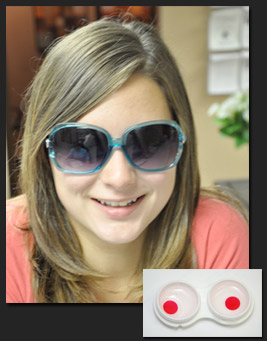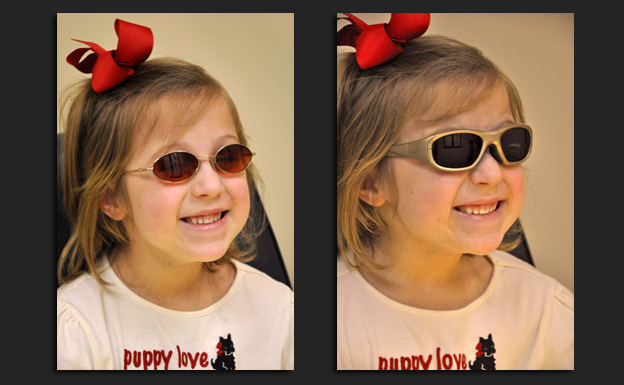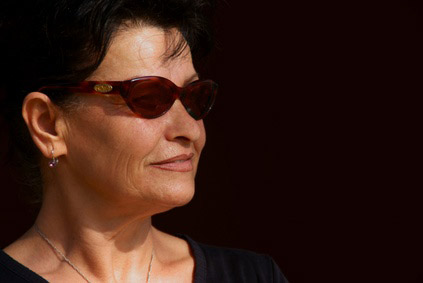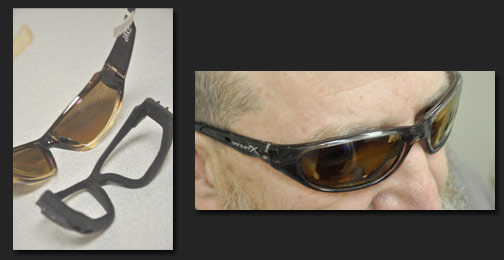Eyewear:Controlling glare inside and outside!
With only about 10,000 achromats in the United States, a country with a combined number of over 50,000 ophthalmologists and optometrists, it is  obvious that few doctors have had extensive experience in designing filtered eyewear or contact lenses for achromats.
obvious that few doctors have had extensive experience in designing filtered eyewear or contact lenses for achromats.
From our doctors’ many decades of work with achromats, we have isolated these key points for designing eyewear. Each patient is unique. We must be able to customize the filter color and darkness to the patient’s functioning. Red, amber and magenta filters are the most common colors, but occasionally some achromats function adequately with gray. The standard stock filters used in general practice may not be adequate for achromats. Custom filters are often required. The filters should be lightened or darken to the patient's needs. Some patients may require more than one shade of sunglasses.
In incomplete achromats, who may retain a small amounts of a specific color vision, prescribing the wrong filter may block that color they have learned to depended on. The filters must be tested with demonstration eyewear or flipper bar filters before prescribing.

Separate Filters Inside and Out
The darkness of the proper inside filter will not be the dark enough for outside. The difference from dim light inside to outside sunlight can vary by 2500 times more brightness. Thus a sunglass that controls light outside fully will nearly always be too dark inside causing problems on dark stairs or in reading. And the perfect tint inside, will be too light outside in bright sunlight. Nearly all achromats need separate level of glare control inside versus outside. At night, any tint may hinder vision.Thus eyewear or contact lenses without filters may be needed at night.
Combination of Filtered Contact Lenses and Sunwear
Filtered soft contact lenses can be fit to control most inside glare and do significantly reduce glare outside, but they do not eliminate the need for additional sunglasses outside. Red color sunglasses typically used by rod monochromats are often not required after fitting with filtered contact lens fitting. Wearing filtered soft contact lenses will usually allow the patient to wear more normal appearing sunglasses in both design and color. The dark amber or blue blocker sunwear popular today may work well.
The Plano Filtered Contact Lenses Approach
Today a wide range of prescription filtered contact lenses can be custom fabricated including lenses for high powers and astigmatism. One approach, however, is to fit the filtered contact lens to fit inside glare needs as a “plano” (no power) lens to be worn under the patient’s general prescription eyewear. In bright outside light a high quality wrap-around non-prescription sunglass may be worn over the patient’s combined eyewear and contact lenses. In dim light situations such as at night the contact can be removed and the patient continue wearing their basic prescription eyewear. This three-part system approach will cover a wide range of glare/light issues.  If the full prescription is fabricated in the filtered contacts, the patient may wear a plano (non-prescription) sunglass over the contacts outside and in some cases a reading or bifocal correction may be worn as needed over the contact lenses inside. Separate clear contact lenses may be added for night or the patient may return to a clear or slightly tinted eyeglass prescription at night. Here, we see a young lady who wears red central contact lenses. She is now able to wear less restrictive plano power over-the-counter sunglass in the more natural color of gray rather than red sunglasses.
If the full prescription is fabricated in the filtered contacts, the patient may wear a plano (non-prescription) sunglass over the contacts outside and in some cases a reading or bifocal correction may be worn as needed over the contact lenses inside. Separate clear contact lenses may be added for night or the patient may return to a clear or slightly tinted eyeglass prescription at night. Here, we see a young lady who wears red central contact lenses. She is now able to wear less restrictive plano power over-the-counter sunglass in the more natural color of gray rather than red sunglasses.
When Filtered Contact Lenses are not an Option
When filtered contacts lenses are not an option, such as in young children and some adults, we must use filtered eyewear inside usually dark filtered (red, plum, or magenta) and a darker outside filter that can slip over the inside eyewear. Remember! The actual darkness of whichever color is used must be customed prescribed. For example, there is not one red tint but a range of red shades.

We may need to design the eyewear in frames that wrap-around to block light from the side, and in sunglasses may use special frames that come with foam inserts that block the leakage of light.
Other Light and Glare Considerations
There may be great variability in light and glare within the achromat's environment such as the overwhelming glare of light of a low lying sun streaming through the windshield or the light from a window behind a computer. Filtered eyewear and sunglasses cannot handle every extreme light problem. So in these cases other devices and strategies must be applied including hats, visors and environmental/home modifications. Hot spots at work or home environment must be reduced with shades or by changing working positions or locations.
Age can be a factor. Young achromats are often more light sensitive than older achromats. This may be owing to the greater efficiency of the young retina and the learned adaptation of the older patients. Young patients may require dark inside filters in their eyeglasses until they reach an age at which filtered  contacts can be prescribed. Dark red filters are often most effective for rod monochromats and magenta is effective for blue cone monochromats. Wrap-around frames or frames with side shields to prevent light leakage may be required.
contacts can be prescribed. Dark red filters are often most effective for rod monochromats and magenta is effective for blue cone monochromats. Wrap-around frames or frames with side shields to prevent light leakage may be required.
Personal preference and experience is also a major factor. Older patients may have never had the appropriate filters in their early years. They have learned to tolerate light, which other achromats might find overwelming. Some patients need more sunlight to avoid feelings of depression. Additionally, the patient’s use of hats or visors may modify the sunwear needs.
Selecting the sunglass frame.
The type of sunglasses frame is important. There are many new wrap-around  sunglasses that block light from the side. Some have foam inserts that can prevent leakage of light around the edge of the frame.
sunglasses that block light from the side. Some have foam inserts that can prevent leakage of light around the edge of the frame.
Opaque side shield can be added to frames but may impair the visual field.

Very Young Patients
In very young patients, special infant frames can be used. Sometimes a non-prescription frame with wrap-around sun shields may be required to control glare. Rx-able wrap-around frames will allow the doctor to insert prescription-filtered lenses.
School Age  Appearance is very important owing to the peer pressure of the other children. Many wrap-around sunglasses are available to cover a wider area. Mirror coating may be used to reduce the red appearance in outside eyewear. It is important to find eyewear the child will like and accept. In adolescent, filtered contact lenses may be a better choice.
Appearance is very important owing to the peer pressure of the other children. Many wrap-around sunglasses are available to cover a wider area. Mirror coating may be used to reduce the red appearance in outside eyewear. It is important to find eyewear the child will like and accept. In adolescent, filtered contact lenses may be a better choice.
Today achromats have the options a great variety of stylish sunglasses that wrap-around to reduce light leakage. Some wrap-around sunglasses come with foam inserts that can block leakage of light around the edges of the frame.

